Click on images to enlarge
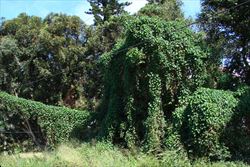
infestation (Photo: Forest and Kim Starr, USGS)
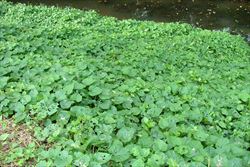
creeping habit (Photo: Sheldon Navie)

climbing habit (Photo: Sheldon Navie)
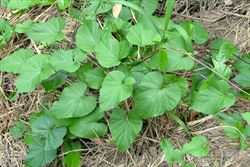
leaves (Photo: Sheldon Navie)
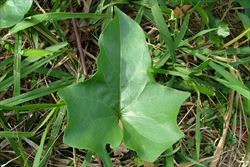
slightly-lobed leaf (Photo: Sheldon Navie)
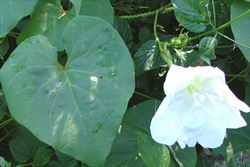
heart-shaped leaf, old flower and stems with small projections (Photo: Sheldon Navie)

close-up of flower bud (Photo: Sheldon Navie)

the long tubular flowers close early in the morning (Photo: Sheldon Navie)
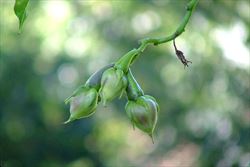
immature fruit (Photo: Sheldon Navie)
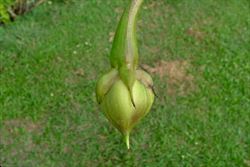
close-up of immature fruit and swollen stalk (Photo: Sheldon Navie)
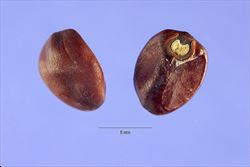
close-up of seeds (Photo: Steve Hurst at USDA PLANTS Database)
Scientific Name
Ipomoea alba L.
Synonyms
Calonyction aculeatum HouseCalonyction bona-nox (L.) BojerIpomoea ambigua Endl.Ipomaea ambigua Endl.Ipomoea bona-nox L.Ipomoea carinata Endl.Ipomaea carinata Endl.Ipomoea grandiflora (L. f.) Lam. (misapplied)
Family
Convolvulaceae
Common Names
evening glory, giant moonflower, moon flower, moon-flower, moonflower, moonflower vine, moon vine, moonvine, tropical white morning glory, tropical white morning-glory, tropical white morningglory, white morning glory, white morningglory, white-flowered morning glory
Origin
Native to North America (i.e. south-eastern USA and Mexcio), Central America (i.e. Belize, Costa Rica, Guatemala, Honduras, Nicaragua and Panama), the Caribbean (i.e. Bahamas, Cuba, the Dominican Republic and Haiti) and South America (i.e. French Guiana, Guyana, Surinam, Venezuela, Brazil, Bolivia, Colombia and Argentina).
Cultivation
Moonflower (Ipomoea alba) has been cultivated as a garden ornamental.
Naturalised Distribution
This species is becoming widely naturalised in eastern Australia. It has been recorded from south-eastern and central Queensland and the coastal districts of northern New South Wales. Also naturalised on Lord Howe Island and Norfolk Island.
Widely naturalised in the tropical regions of the world, including south-eastern Asia and many Pacific islands (e.g American Samoa, French Polynesia, Hawaii, Tonga, New Caledonia and the Galápagos Islands).
Habitat
This species has escaped cultivation and invaded watercourses, riparian areas, moist forests, urban bushland and disturbed areas (e.g. in parks, along roadsides, and along railway lines) in the sub-tropical and tropical regions of Australia.
Habit
This short-lived (i.e. annual) or long-lived (i.e. perennial) vine can climb over shrubs and trees, or spread out and over the ground and form a dense mat of vegetation.
Distinguishing Features
-
a scrambling or climbing plant with hairless stems that sometimes have numerous small projections.
-
its alternately arranged leaves (5-20 cm long) are borne on long stalks and are sometimes slightly fleshy in nature.
-
these leaves are usually heart-shaped with pointed tips, but can sometimes be slightly lobed.
-
its trumpet-shaped flowers (10-15 cm wide) have a very long and narrow greenish-white floral tube (7-15 cm long) and five large white spreading lobes.
-
these flowers open at night, hence the common name “moonflower”, and usually wither by early the next morning.
-
its mature capsules (2-3 cm long) split open to release four hairless, whitish-coloured, seeds (about 10 mm long).
Stems and Leaves
Its stems are hairless (i.e. glabrous), but the aerial climbing stems sometimes have numerous small projections.
Its relatively large leaves (5-20 cm long and 4-20 cm wide) are alternately arranged along the stems. They are borne on stalks (i.e. petioles) 5-18 cm long and are somewhat thick or occasionally even slightly fleshy in nature. These leaves are usually strongly heart-shaped (i.e. cordate) with pointed tips (i.e. acute apices), but can sometimes be slightly lobed.
Flowers and Fruit
The large trumpet-shaped (i.e. tubular) flowers have a very long and narrow greenish-white floral tube (7- 15 cm long) and five large white spreading lobes (10-15 cm wide). They are borne in several-flowered clusters, or occasionally singly, in the leaf forks. These flowers open at night, hence the common name “moonflower”, and usually wither by early the next morning. They have five small sepals (5-20 mm long) with pointed tips (i.e. acute apices) and are borne on stalks (i.e. pedicels) 7-15 mm long. Each flower has five whitish-coloured stamens and a style that are exerted from the end of the floral tube. Flowering occurs during summer and autumn.
The fruit is a small capsule (2-3 cm long) with a pointed tip (i.e. acuminate apex). As the fruit matures the flower stalk becomes enlarged, and when fully mature the fruit turns from green to dark brown or blackish in colour. It then splits open to release four large, hairless (i.e. glabrous), whitish-coloured seeds (about 10 mm long).
Reproduction and Dispersal
Reproduction in this sepcies is by seed or vegetatively via rooting of stems that creep along the ground (i.e. adventitious roots).
Seeds and pieces of stems may be dispersed in dumped garden waste and are probably also commonly spread by water movement.
Environmental Impact
Moonflower (Ipomoea alba) is regarded as an environmental weed in New South Wales and Queensland. It is currently mainly found in and near heavily populated areas, but it has the potential to become a serious weed of rainforest gaps and margins, wet sclerophyll forests and riparian areas throughout the coastal districts of Queensland and northern New South Wales.
This species was first recorded as naturalised in Queensland in 1985, but has become increasingly common and widespread in south-eastern Queensland since that time. Moonflower (Ipomoea alba) is now well established in this region, where it has been observed to form very dense mats of vegetation along waterways and up over riparian vegetation.
It also appears on regional and local environmental weeds lists in north-eastern New South Wales. In this region it is most common in the Tweed River district, though substantial infestations are also found in the Clarence River catchment. Moonflower (Ipomoea alba) is also listed among the "exotic vines and scramblers" whose invasion of native vegetation is regarded as a "key threatening process" in New South Wales.
Legislation
Not declared or considered noxious by any state government authorities.
Similar Species
There are several closely-related species with very similar foliage to moonflower (Ipomoea alba), including obscure morning glory (Ipomoea obscura), common morning glory (Ipomoea purpurea) and blue morning glory (Ipomoea indica). Obscure morning glory (Ipomoea obscura ) is the most similar, but its white flowers are much smaller than those of moonflower and have a much shorter floral tube (only 14-25 mm long). This species is only present in northern Queensland.
Blue morning glory (Ipomoea indica) and common morning glory (Ipomoea purpurea) are similar when not in flower. Their leaves are often heart-shaped, like moonflower (Ipomoea alba), but they are sometimes deeply three-lobed. These species also have smaller flowers with shorter floral tubes (only 5-8 cm long) that are often pink or purplish in colour.

